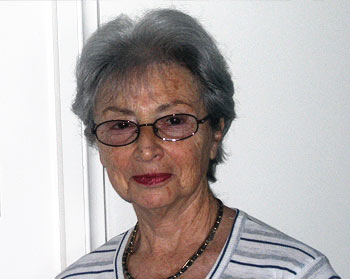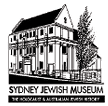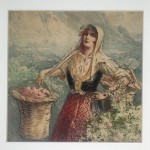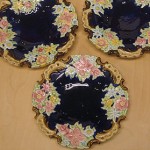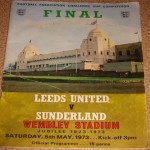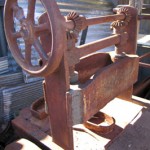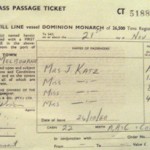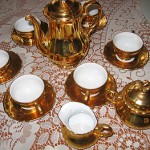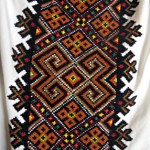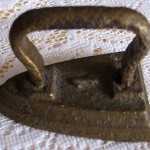(nee Gero)
Jewish
Sofia, Bulgaria
Santiago, Chile in June 1971
Sydney on 3 December 1971
With friends in Northbridge, Sydney
Endeavour Hostel, Maroubra, Sydney in August 1972 for 6 months
Grace Bros, Roselands, Sydney
In Sydney: fashion boutique in Double Bay and Australian Department of Immigration, Martin Place
I was born in Sofia, Bulgaria where I have memories of a very happy and untroubled childhood. This ended suddenly when the Germans invaded in 1942 and we moved to Hungary. I was 13 and not at all pleased to have to start a new school and education system and my Hungarian was not fluent.
These lovely watercolour paintings used to hang in our home in Sofia and then again in Hungary. They are painted by Morozov, a famous Bulgarian artist. The town scene with the cobbled streets is a place called Plovdiv, second only to Sofia. Bulgaria is famous for its roses and the production of rose oil, and this picture is called ‘Where the roses grow’. Another picture shows a Bulgarian spinning lady. And these two paintings show typical street life, with cobbled roads and trades people. When I got married I asked my parents to give these to me. These are the only objects that we have from Bulgaria.
I met George, my husband-to-be, soon after we arrived in Hungary. I first noticed him at a New Year’s Eve party but was not so interested in him. Then Hitler unexpectedly invaded Hungary in 1944 and everything changed.
My mother, grandmother and I survived the war. We managed to get protection through Wallenberg1 in a protected house outside the Jewish ghetto in Budapest. My brother suffered the last year of the war in the concentration camp of Mathausen. On his return after the war, he was like a walking skeleton and weighed 32 kgs. He was completely unrecognisable. When I first saw him on the street, I thought he was some dirty and ugly vagabond. I quickly ran away from him and then I heard his voice, as he asked me, “Don’t you recognise me?”.
My father was taken to work in a forced labour camp from which he was due to be deported. He heard that the Russians were close, so he hid in the forest waiting for them. As he was fluent in Russian, my father came back with the Russian army as the interpreter of one of its sections.
George survived the war by hiding in Budapest but he lost every single family member. After the war, he happened to see me one day on the street. He was completely alone and so started to come to our house quite often. Very shortly after that he asked me to marry him. We married in February 1946. I was 16.
The communists had taken over Hungary and we had no trust in the new system. We were very keen to leave war torn Europe far behind. We left Hungary as soon as we could.
My brother was already in South America and since we had no one else outside Europe that was our natural choice. We were permitted only one suitcase and it was actually illegal to bring valuable things out of the country. As well as my precious paintings, we took these special hand-painted Hungarian plates. These were left from George’s family home. The plates belonged to George’s parents and George remembers well how his mother would use these plates for very special occasions. We hid the items below our clothes and luckily the aeroplane was about to go so the officer had no time to search our bags. These six dessert plates are so beautiful and precious that I use them only as decorations.
We first arrived in Uruguay in 1948; my parents arrived a year later. After four years we moved to Chile where my children Rita (1952) and then Robert (1954) were born. We were very happy there but when the communist regime with Allende 2 came to power, our experience of Hungary was enough to convince us not to stay. We considered whether to immigrate to Canada, Israel or America. In June 1971 we took a round-the-world ticket and investigated our prospects in Canada and Israel.
We came to Sydney to visit friends in December 1971. En route in Hong Kong, we met an Australian woman who heard us speaking Hungarian. She was the editor of the Australian Jewish Times and soon became and remained a very close friend of ours. On arrival, we just fell in love with the city. What struck me immediately was the beauty and the openness of this place. Everything, really! We liked it so much that we decided to go to the Department of Immigration. A very nice young lady, Paula, assisted us and advised that as long as our police records were in order, we could stay in the country. We couldn’t believe our luck.
In seeking work we were advised by a migrant advisor that even though we travelled on a Chilean passport, when seeking work we should say we were Hungarians rather than Chileans. I was upset by that remark. He quickly explained that he was in fact married to a Chilean woman but that the Hungarians have the fame of being very good workers. I followed his advice.
My first job was in ladies fashion at Grace Brothers. My husband also got a job in the hardware department. I remember that I used to hide when the telephone rang as I found the Australian accent so difficult to understand over the phone. However, I excelled as a saleslady.
Then in February 1972, after a few months of settling in, I received a letter that my father was sick and my daughter wanted to get married. We returned to Montevideo, Uruguay but in our hurry we forgot to ask for a re-entry permit. We were forced to completely reapply for emigration to Australia and arrived again in Sydney as new immigrants in August 1972. On arrival, I was handing my passport to someone without really looking up and they greeted me with a friendly ‘Hullo Mrs Faludi, and how are you?’ It happened to be Paula. It was a wonderful welcome.
We stayed at the Endeavour Hostel in Maroubra [beach suburb in Sydney 's east] for new migrants. I was surprised by how very well they looked after us. Robert, my son, was 18 and slept on a mattress in the entrance. We had a tiny room with two beds, a wardrobe, a washing basin and tea making facilities. The showers were communal, of course. But it was comfortable. We were well looked after with abundant and good food available at three meals a day. We received English lessons, guidance about life in Australia and were even offered financial help. We tried to learn as much English as we could over the six months we stayed in the hostel. We left when George and myself had found jobs and a home for our family. We had made friends with other Chileans who were staying there and my son, Robert, met his future wife through these connections. I am really very grateful to Australia for that period of receiving us and really, it was just open arms!
My very first job in my second migration to Australia was in Double Bay [Sydney's eastern suburbs] with a Hungarian high fashion boutique. After a few months, I decided to try and get work as an interpreter as I was fluent in Hungarian, French, German, Spanish and some English. I longed to work for the Immigration Office and applied. Eventually I got a job there as an interpreter on a casual basis. I accompanied migrants to the doctors, the solicitors or wherever was needed. I was paid as a casual and continued my other job until eventually the Department of Immigration offered me a permanent position as a telephone interpreter in the department itself. The shifts covered a 24-hour period and I found the night shifts quite a strain. After a couple of years I applied for a position in the citizenship section.
After my own positive experience as a migrant to this country, I set my mind on working with migrants and making a difference. I really wanted to work in citizenship and I set this possible job as a goal to achieve. I had to study very hard as I was competing with much younger and more educated people for the position. I completed extensive application procedures and attended many interviews. Eventually I enthusiastically started my career as an officer class 2-3 in 1975 and finished up as a class 5 in citizenship. I became the ceremonies clerk, which involved not only interviewing, but also authorising/rejecting, attending and conducting citizenship ceremonies and representing the government at them. I loved my job and I was really, really happy there. I had to retire in 1995 at the age of 65.
Working in this department opened my eyes to the different sorts of migrants that come to Australia. Some people seem to imagine that the country owes them something and want to take without giving anything back. This really annoyed me. In Europe and South America the governments gave absolutely no assistance to their migrants. If you didn’t have a job, you had nothing. When we came, we worked hard to learn English as quickly as possible; we were so grateful for everything the government gave us. We tried our best to make a positive contribution.
I continue to meet people who greet me in the street and remember that I conducted their citizenship interviews or ceremony. When I first went to the surgery of our family doctor, she said, ‘Hello Mrs Faludi, how are you’. I said, ‘How do you know me?’ Yes, I even interviewed our family doctor. I have letters of gratitude from many mayors, the ombudsman, the offices of the Prime Minister and Mrs Hazel Hawke 3, all of whom were very happy with the citizenship occasions I officiated.
I think that we are lucky to have migrated to Australia . We are thankful that my daughter and son with all their children are here, so our family are together. This is a very lucky country if you want to make it your lucky country. We worked hard to integrate and we were accepted.
1. It is estimated that Raoul Wallenberg, the son of a Swedish diplomat, saved possibly tens of thousands of Jews during the Nazi Holocaust in Hungary. He was captured by the Soviet Union in Budapest, Hungary in January 1945, near the end of World War Two, and possibly seen alive in Soviet prison camps until the 1970s. Subsequently, Wallenberg was awarded the status of Righteous Among the Nations by Israel.
2.Salvador Allende, a communist, became the President of Chile in 1970.
3. Mrs Hazel Hawke is the former wife of Mr Bob Hawke, Prime Minister of Australia 1983-91.


